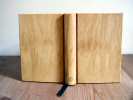
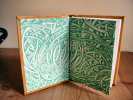
11.5 x 15.3 x 2.5 cm
Springback book of cream laid paper, with leather-jointed paste paper endsheets. Covered in wrinkle-dyed golden bookcalf. Blind tooling.
This book, like the pale book, the traditional half-binding and the subduction springback, is the remnant of an abandoned experiment in endpaper structures. The book blocks came in handy when I decided to explore the tradition of springback bindings.
Traditional bookbinding, particularly in the United Kingdom, was divided into two categories. There was "edition" binding, which bound printed sheets of paper into books. This is the ancestor of the practice of "fine binding" pursued by hand bookbinders all over the world. But in addition to, and completely separate from this tradition was the dicipline of "stationery" or "account" bookbinding. Unlike fine binding, this tradition is almost dead, at best a rare variation on the more common practices.
Books produced by stationery binders were meant to be written in as well as read. They used a "spring back" to throw the gutter of the page up, presenting a level writing surface. Springback books were traditionally used for account ledgers, among other purposes. This probably explains their disappearance from the bookbinding scene, since accounts are now almost exclusively kept on computers.
(Interesting historical note: account book blocks traditionally had marbled page edges. This may seem like a surprisingly decorative thing to do on an essentially utilitarian book form, but it did serve a logical purpose. Removing a page from the book - say, to cover up that embezzlement one has been doing - leaves a visible gap in the marble pattern.)
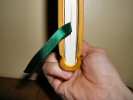 |
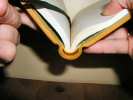 |
*POP* |
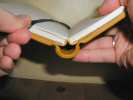 |
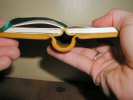 |
Every illustration of a springback book I've seen has left me with the impression that it's basically just a hollow-backed book. It wasn't until I made my own and opened it for the first time that I grasped the essential, intriguing difference. I almost laughed aloud at the sudden "pop" as the spring back pushed the open pages flat in my hands. So let me try to explain.
An ordinary hollow backed book is backed as well as rounded, giving the spine a permanent covexity. The back of the hollow is not structural, but merely protective. It flexes with the book, but doesn't drive the book's opening.
By contrast, a springback is a structural element to the book. The book block has not been backed, but has been rounded to an extreme enough degree to eliminate the swell. This means that it's still capable of flexing from a purely convex configuration. The constraints of covers and spine lining mean it can't go truly concave, but it can develop a "point" where the pages spread open. The spring back is designed to push the spine into one of two positions, either closed (a normal rounded unbacked book) or open. Though the spring does flex enough to permit transition between these two states, it won't allow the book to remain half-open, with the gutter in the way of smooth writing, like a normal book.
Go to this page and follow the instructions. That's what I did. I have other books describing variations on the process, but that link is the best end-to-end description I've seen. There's no point my reproducing it.
I was going to use an ordinary leather on this book, then decorate it with a back-pared onlay of some sort. No real inspiration gripped me. But looking through my leather, I came across a hide that got wrinkled at some point in the dyeing process. As a result, it looked almost tie-dyed, like tiger stripes or wood grain.
 My memory of this hide is that it was hard to trim and work with, but that impression is based on the Christmas bindings for 2002, when I had been biding for only a year. I've since learned a lot about leather paring and (key point here) sharpening my paring knife.
My memory of this hide is that it was hard to trim and work with, but that impression is based on the Christmas bindings for 2002, when I had been biding for only a year. I've since learned a lot about leather paring and (key point here) sharpening my paring knife.
In short, it pared just fine, and gave me minimal trouble overall. It had a tendency to bleed ochre on the page edges, but a quick sanding fixed that. Now, as I use it, it is becoming shiny and polished with use. I can tell that this leather will age gracefully.
The rest of the book is fairly standard: cream laid paper, machine-made headbands (I haven't yet learned how to hand-sew headbands for account books), and hand-decorated paste paper endsheets. I even got the endsheets the right way round on the front, so that the design continues over the leather joint.